FUTURE STYLE
|
for Mac / Windows 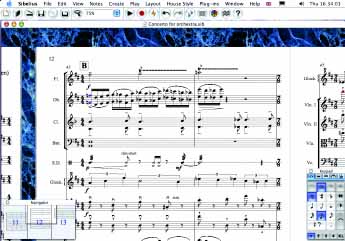 848 EUR 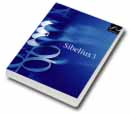 The Sibelius screen is simple and intuitive. To look around the music, just click and drag the page . Alternatively, drag the Navigator to move smoothly through many pages at once. The Sibelius screen is simple and intuitive. To look around the music, just click and drag the page . Alternatively, drag the Navigator to move smoothly through many pages at once.You can even choose different colors and textures for the paper and desk on the screen. Sibelius 3 comes with a printed manual, which is non-technical and explains all the main features in just 50 pages Creating music Start a score from scratch, specify instruments, page size, title, tempo etc. with a few clicks. Your score is set up instantly, all of the instruments with the correct names, clefs, transpositions and layout. Then you can input notes in four ways MIDI input - Flexi-time is Sibelius’s system for notating music as you play it on a MIDI keyboard in real time. There’s no need to tap a pedal or play mechanically , just play naturally with both hands, and Sibelius will actually follow you as you speed up or slow down. You can listen to the music you’ve already written as you play in more music on top.  larger size Step-time- lets you play pitches from your MIDI keyboard with one hand, and choose rhythms and articulations with the other from the keypad. Keypad - Choose notes, articulations etc. with the mouse or corresponding numeric key. There are five different sets of symbols to choose from 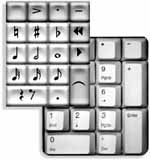 Mouse and keystrokes - To input without a MIDI keyboard, pick note-values and accidentals from the keypad with the mouse, and click to place them in the score. For extra speed, use the computer keyboard instead, specify pitch using the letters A to G, and rhythms from the keypad using the numeric keys . You can get other markings such as clefs, slurs and time signatures from menus; Sibelius even positions them in the right place for you. Scanning Sibelius includes PhotoScore Lite , a program for scanning printed music. It takes just seconds to read a page, and you can then edit or transpose the music in Sibelius, play it back, extract parts and print, just as if you’d inputted it yourself. The advanced version PhotoScore Professional (developed by Neuratron and which you can buy with Sibelius) has many extra features, such as reading slurs, articulations, hairpins and text. File conversion Sibelius seamlessly opens Finale, SCORE, Allegro, PrintMusic, MIDI and NIFF files ; a way to transfer your existing music to Sibelius. Composing and arranging Sketch & refine Sibelius 3 lets you change music whenever you like. Sketch a solo flute piece, then add a whole orchestra to create a concerto. Write in sounding pitch, then make a transposing score with one click. Add extra bars at the start of a score, and Sibelius instantly reformats every page. If you change your mind, Sibelius lets you undo up to 10,000 operations, and keeps backups of 40 previous versions of your music. Text and lyrics Sibelius puts different types of text, such as dynamics, titles and lyrics, in the appropriate font, size and position. You can edit these text styles to change text consistently throughout the score. To input lyrics, just type: Sibelius positions the words under the notes, puts in hyphens and lyric lines, and allows extra room for long syllables. You can also copy lyrics from a word processor. Arrange Arrange is the feature to help with arranging and orchestration. It’s ideal for students learning instrumental writing, and saves hours of time for experienced professionals. Just select some music, and specify how you want it to be arranged or orchestrated; Sibelius does the rest in an instant, using appropriate instruments, doublings, etc. It handles anything from keyboard reductions and ‘exploding’ chords onto separate staves, to sophisticated arrangement and orchestration styles, such as Band (using high brass and pitched percussion), Choir (tenor doubling soprano down an octave), Jazz (in the style of famous band leaders including Sammy Nestico, Billy Strayhorn and Thad Jones), Impressionist orchestration with harp and strings. Over 150 of these styles are provided, and you can even create your own. Copying and transposing Sibelius copies anything with one click of the mouse , especially useful for doubled instruments and repeating figures. You can make multiple copies at once, for example to put the same dynamics onto every instrument. Sibelius transposes music instantly into any key, and handles everything about transposing instruments for you. Write music in sounding or written pitch, and switch between the two whenever you like. 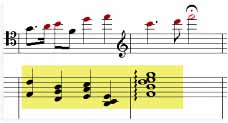 Unplayable notes shown in bright red, difficult notes in dark red highlights Mark music with the highlighter pen Checking for mistakes Sibelius spotts all kinds of mistakes such as rhythms that don’t add up, or notes that are too high/low to play . Sibelius knows every instrument’s range, which you can adjust for players of different abilities. Sibelius comes with various proof-reading plug-ins , including ones which add cautionary accidentals and even mark parallel fifths and octaves. Playback Simple playback controls with tempo slider Playing back your score Just click the play button to hear your music performed . Sibelius reads, understands and plays back all standard markings including trills, repeats, cresc./dim. hairpins, 8vas, glissandos, percussion and drum sets, guitar tab, and even quarter-tones. Mixer 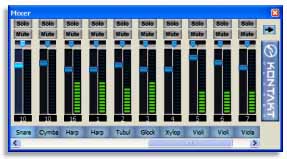 Mixer: adjust sounds, volume and pan position; solo or mute particular staves, etc. Sibelius understands musical words and phrases such as: rit., pizz., Allegro, mute, swing, and change to Piccolo. Musical terms in various languages are already defined in a built-in dictionary and you can add new words to it, too. Sibelius lets you select specific instruments and sections of music to listen to, automatically playing the correct instrumental sounds through your soundcard or MIDI equipment. Kontakt Player and creating CDs Sibelius includes Kontakt Player Silver from Native Instruments, which provides playback of 19 pitched sounds and 100 unpitched percussion sounds . You can also buy Kontakt Player Gold, which has 64 pitched sounds and 110 unpitched percussion sounds, covering orchestral, band, jazz etc. , even Bass Clarinet, Flugelhorn, string techniques (e.g. sul ponticello tremolo), male/female voices and choirs, and so on. Extra sound libraries are coming soon. Sibelius 3 also let you to create CDs and MP3 files for performers and friends, using the Kontakt Player sounds. Live PlaybackLive Playback and Mixer 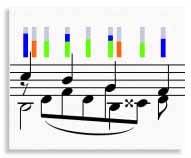 More advanced users can fine-tune playback in real time with the Mixer , and use Sibelius's Live Playback feature to tweak the nuances of your original performance. You can adjust the dynamics using these colored bars . Espressivo and Rubato Espressivo and Rubato are unique features which add elegant expression as Sibelius plays. Espressivo makes subtle adjustments to the dynamics to produce musical phrasing, and Rubato varies the tempo, just like a human performer. Rhythmic feel, SoundStage and reverb Sibelius lets you choose from numerous "rhythmic feel" styles which make subtle enhancements to the rhythm , anything from jazz swing to Viennese waltz. When playing back scores for ensembles such as orchestra or band, Sibelius’s SoundStage feature positions the sounds correctly in 3-D space, as if the instruments were on a concert stage. You can also choose the reverb characteristics of different natural acoustics. Because Sibelius has such sophisticated playback features, you can use it for far more than just listening to music. Sibelius makes it easy to check the notes you’ve written, accompanies while you practice, and helps you make rehearsal tapes and CD recordings of your music. 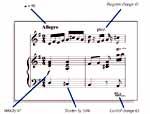 larger size When playing, Sibelius converts all standard markings into MIDI information Repeats Sibelius 3 supports complex repeat structures with up to 8 repetitions. You can even make Sibelius jump between arbitrary points in the score during playback, e.g. to skip guitar fill boxes or simulate aleatory performances. You can make individual notes, dynamics etc. apply only to certain verses or repeats, so you could have the brass play only the second time round, or make verse 3 p and verse 4 f. Timecode now shows separate timings for each repeat. Page layout and part extraction Page layout Sibelius's page layout means that you won't have to worry about spacing, formatting, or how your score will look when it's printed. The Optical spacing algorithm ensures your music is laid out on the page. If bars get too cramped, it pushes them onto the next page, and adjusts slurs, hairpins etc. to suit. House styles Sibelius 3 applies hundreds of subtle music engraving rules to optimize your score's appearance. You can adjust these rules and design your own house style(s) to make your music look distinctive. You can even save house styles to disk and import them into other scores. Controlling layout yourself If you prefer, you can change the layout yourself: you can move staves around, specify page and system breaks, lock the format of pages, alter note spacings, and squash up or spread out whole passages of music. You’re in complete control. Part extraction Sibelius 3 extracts instrumental parts and transposes the music if necessary, inserts cues (which you can mark in the full score), and even adds convenient page turns automatically. Tools 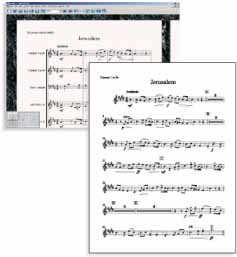 Plug-ins Sibelius comes with more than 60 ‘plug-in’ features to: Check for mistakes, e.g. parallel 5ths/8ves Add brass/string fingering Automatically create sets of scales and arpeggios Halve or double note values Add appropriate chord symbols above chords Realize figured bass and chord symbols Automatically generate drum patterns Highlight all occurrences of a motive Sibelius includes a complete programming language called ManuScript, so you can even write your own plug-ins. Properties The Properties window lets you view and edit advanced information about markings in your score ,everything from numerical positions to notehead shapes and text sizes. The information is divided into panels, which you can open and close to reduce screen clutter. 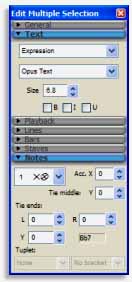 Properties window shows advanced information divided into seven panels Rulers Sibelius’s rulers show you individual position measurements for each marking and staff , useful for making fine adjustments to layout. Find and filters Sibelius lets you search for notes, text and other markings,. Filters let you find and edit any number of these occurrences at once. For example, you can easily find all C#s in a harp part, then change them all to Db with a single keypress.  larger size Multiple rulers (this score uses the Inkpen2 handwriting font) Timecode and score duration  larger size Timecode above barlines Sibelius calculates the time position (timecode) of every bar and the total duration of the score, useful for film/TV scoring, or for any work which requires timings. Timecode is written above barlines and shown as a digital clock during playback, taking into account tempo marks, irregular bars and rits/accels. Display formats include seconds, centiseconds and various frame rates. This feature does not display or sync to incoming SMPTE or MTC. Publishing House Styles and engraving rules Sibelius automatically applies hundreds of subtle music engraving rules to optimize every aspect of your score’s appearance. You can set ‘House Style’ options to emulate the high-quality appearance of famous publishers, or design your own house style(s) to make your scores look distinctive. A whole menu of options is included, to control everything from text styles and notehead shapes to complex engraving rules. You can even save house styles to disk and import them into other scores.  larger size Control parameters such as beam angles individually or by adjusting Sibelius’s engraving rules Graphics and color Sibelius imports color and black-and-white graphics, for adding pictures, logos, photos, cover pages and special notations to your music. Sibelius comes with dozens of graphics ready to use or create your own. You can color in notes, text, symbols, etc. , useful for educational music, marking up sketches, and making important markings stand out. They print in color, too. Colored staves 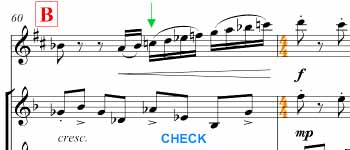 Color anything in You can also export music from Sibelius to graphics, desktop publishing and word processor programs in a variety of standard file formats, e.g. EPS and TIFF. This makes it easy to incorporate music into anything from coursework and exam papers, to books and posters. No ‘faking’ Sibelius automatically handles many tricky notations that other programs have to fake, such as: collisions between voices (layers), multi-arc slurs with any number of arcs, beams over rests and across barlines, cross-staff beams between three staves, text and wavy lines at any angle (e.g. gliss.), and ossias. Music fonts and symbols Sibelius’s standard music font Opus produces an high-quality appearance, supplied with alternative noteheads conforming to the US Music Publishers’ Association design standards. Also included is Inkpen2 , a font which simulates handwritten music and text . Sibelius’s fonts include over 450 music symbols you can use, such as special noteheads, percussion markings, ornaments and avant garde notations. But you’re not just limited to Sibelius fonts. Sibelius is compatible with many music fonts, including Petrucci , Jazz, Susato, Sonata, Tamburo and Ghent. You can even design your own symbols using any combination of characters from any mixture of fonts.  larger size Hundreds of customizable symbols Internet publishing Scorch coursework Sibelius not only prints your music conventionally, but also lets you put it onto your own web site, or onto SibeliusMusic.com, the site for self-publishing scores. From your own web site, anyone, anywhere can view, play, transpose and print your music. Visitors to your site don’t need Sibelius, they just download Scorch, (Sibelius' free plug-in for browsing scores online). You can also let people save music from your site onto disk , useful for giving coursework to students. From SibeliusMusic.com you can publicize and sell your music worldwide. You can even include your biography, photograph, contact details and list of scores on your own page on the site. Sibelius Internet Edition Sibelius Internet Edition is a special version of Sibelius for commercial Internet publishing, used by leading publishers such as Hal Leonard, Music Sales and Boosey & Hawkes. (The standard Sibelius program is not licensed for commercial Internet use.) 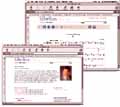 larger size A composer's page on Special notations Many different forms of music notation have evolved over the past ten centuries. With Sibelius, you can create scores in any of these styles. Avant garde notation Sibelius handles modern notations such as quarter tones (which play and transpose), complex tuplets (with multiple nesting), feathered beams, colored markings, extreme note values, music in multiple keys, and special note designs. To cover all eventualities, you can import graphics for invented notations and graphic scores. Guitar tab and chord diagrams You can input tab just like other music (using MIDI, mouse or keystrokes), or you can instantly convert notation to tab, or tab to notation. Sibelius has support for markings such as bends, slides, hammer-on and vibrato bar. These too automatically convert between notation and tab. You can even write tab for any fretted instrument (mandolin, banjo, lute, dobro...), in any tuning you like. To get a chord diagram, just name the chord you want, and pick the frame from the choice given. In fact, Sibelius calculates all possible positions for any standard chord. And like tab, Sibelius produces chord diagrams for any fretted instrument, in any tuning. larger size Choosing chord diagrams; automatic guitar tab notations Jazz, commercial and rock music  larger size Chord symbols, drum sets, slashes and other popular notations are all included, plus the special Inkpen2 font to make your printouts look handwritten. Early music For early music, Sibelius easily notates ossias, figured bass, numerous ornaments, incipits, all C-clefs, special barlines, stemless notes and longs. It even writes and plays back lute tablature.  larger size Teaching with Sibelius Primary/Elementary, Secondary/High Schl, University/College, Professional, Home, Instrument lessons Sibelius is useful for all educational levels, it’s easy for beginners, yet sophisticated enough for all university requirements. Special discounted educational pricing and site licenses are available. Sibelius helps teachers with lesson preparation, such as creating worksheets, handouts and exam papers. It lets students hear how their work sounds, makes it easy to find and correct mistakes. At university level, Sibelius satisfies advanced requirements, from avant garde and early music notation to Schenkerian analysis. If you’re an instrumental teacher, Sibelius makes it quick to create exercises, scan in and transpose pieces, and produce accompaniments and arrangements . Color Internet studying With Sibelius, you can put coursework onto your school/university web site for students to view, play, print and save to disk. You can also get thousands of worksheets, exercises and pieces from other educators on Sibelius web site. Sibelius has a special button for free time-limited access to Grovemusic , the Internet version of a music encyclopedia. Arranging and transposing It’s ideal for students who are learning arranging, composition or even orchestration. Exercises for different instruments or abilities.  larger size Create exercises, worksheets and handouts quickly Playback When playing, Sibelius selects the right instrumental sounds, reads markings straight from the score and adds expression, so students get a realistic rendition of their music right away. And they can check for mistakes, just by listening. Color and graphics Notes which are too high/low are shown in red; you can adjust instrument ranges to write for players of different abilities. Music can be hidden, so students can fill in an exercise on computer and then reveal the right answer. Sibelius lets you add color, pictures and graphic notations to coursework; lots of graphics are included. You can also take music from Sibelius into word processors and graphics packages, for creating worksheets, posters, etc. in other programs Plug ins  Sibelius includes dozens of graphics to add to worksheets and scores or use your own instead Plug-ins Sibelius includes many educational plug-ins, to automate tasks such as writing note names and beats above notes, creating sets of scales and arpeggios, adding brass/string fingering and tonic sol-fa, and identifying motives for musical analysis. Sibelius Notes  larger size Sibelius Notes is a separate pack of educational resources to help students learn music with Sibelius, and to save time preparing lessons. It’s suitable for all school levels and abilities, from basic notation to Bach chorales, and contains: -Teacher’s Guide: over 200 pages of ready-to-use exercises, worksheets and resources Sibelius 3 computer requirements Windows Windows 98/Me/NT4/2000/XP, Pentium or faster, 64Mb+ RAM (128Mb+ for Windows 2000/XP), 70Mb hard disk space. Scanning may need more RAM. Macintosh OS 9.1/9.2/10.1.5 or later, iMac/G3/G4/G5,128Mb+ RAM (OS 9) or 192Mb+ RAM (OS X), 70Mb hard disk space. Scanning requires TWAIN-compatible scanner and may need more RAM. Sibelius 3 does not support Windows 95 or Mac OS 8.6/9.0. Mac OS 9.0 Kontakt Player Silverand Save as Audio Track To use either of these, you will need: Windows 98/Me/2000/XP (not NT4) or Mac OS 9.1/9.2/10.2 or later (not 10.1.5); 250Mb free hard disk space (in addition to Sibelius 3); and preferably a separate sound card. Additionally: Recommended (scores that use several different sounds): Windows: 700MHz processor or faster, 256Mb+ RAM Mac: G4/G5, 256Mb RAM Kontakt Player Gold (separate purchase) Requires 750Mb hard disk space (in addition to Sibelius 3), Windows 98/Me/2000/XP (not NT4), Mac OS 9.1/9.2/10.2 or later (not 10.1.5). Scores that use up to about 8 different sounds: Windows: 700MHz processor or faster, 256Mb+ RAM, preferably separate sound card. Mac: G4/G5, 256Mb+ RAM, preferably separate sound card. Scores that use up to about 20 different sounds: Windows: Pentium 4 or Athlon XP, 256Mb+ RAM. Preferably Windows 2000/XP; 512Mb RAM or 7200rpm hard disk; separate sound card (ASIO driver support recommended); separate graphics card. (Computers that do not meet all of these requirements may still be able to play 20 different sounds.) Mac: G4 (preferably 1GHz+) / G5, 512Mb+ RAM. Preferably 768Mb RAM or 7200rpm hard disk; separate sound card (OS 9: ASIO driver support recommended). (Computers that do not meet all of these requirements may still be able to play 20 different sounds.) Scores that use more than 20 different sounds may need a fast processor, more RAM and a separate soundcard |
Sibelius USA Inc 1407 Oakland Blvd, Suite 103 Walnut Creek CA 94596 Rest of world contact Sibelius direct as follows: Tel: +44 20 7561 7999 , Fax: +44 20 7561 7888
|
advanced technologic sound magazine 2004 january issue 121
|

